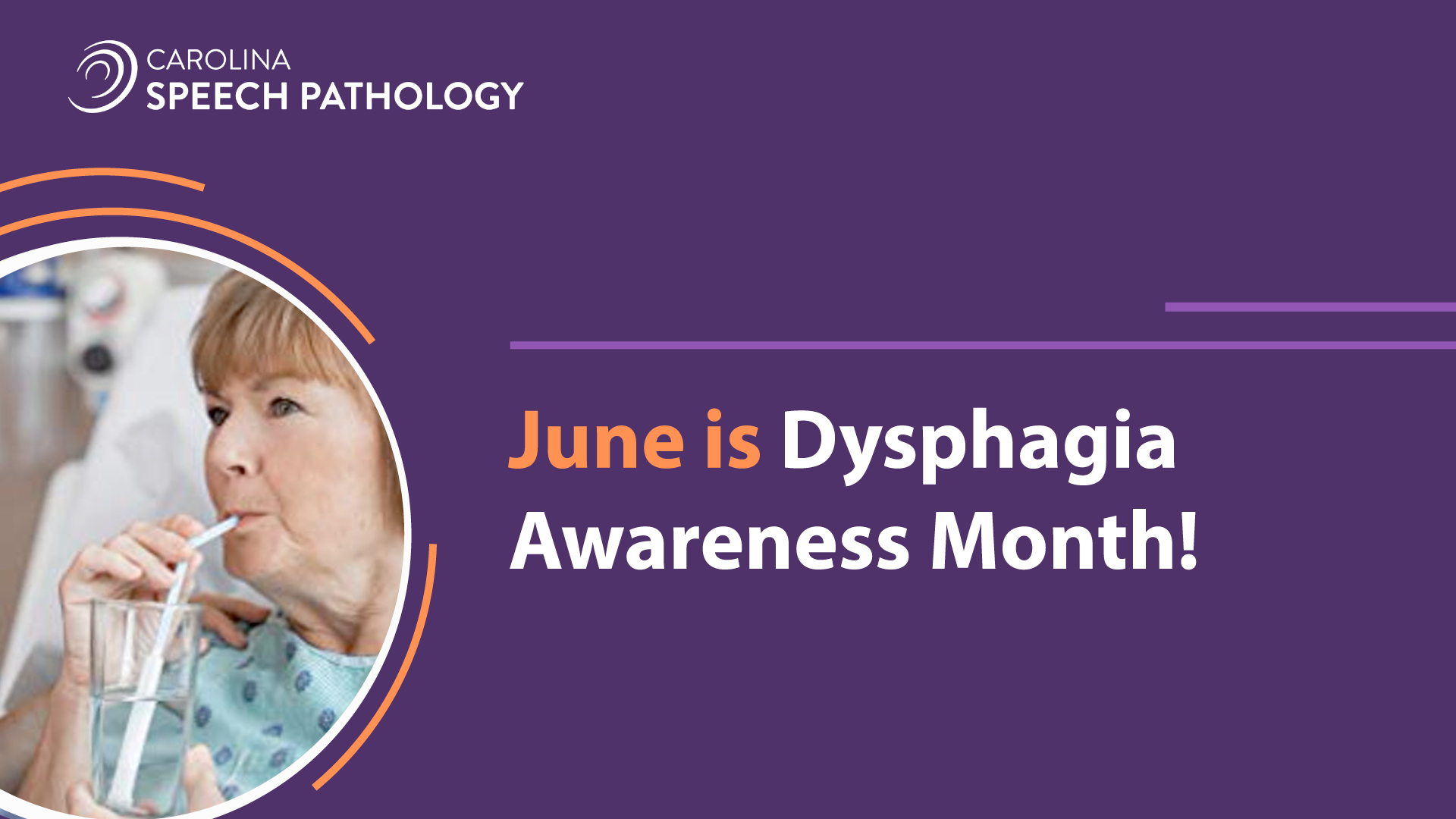June was established by U.S. Congress as National Dysphagia Awareness Month in 2008. Those who work with patients with swallowing disorders and those who have been impacted by dysphagia take time during this month to bring awareness to this diagnosis, which can be a huge burden on the patient, their caregivers, and the healthcare system as a whole.
Working with patients with dysphagia is the core focus of what we do at Carolina Speech Pathology. Because this diagnosis is near and dear to our hearts, we put together a list of facts about dysphagia in order to do our part in spreading awareness. But first, we’d like to define and describe dysphagia for our readers who may not be familiar.
Dysphagia is defined as difficulty swallowing. These difficulties may occur in the oral cavity, pharynx, esophagus or gastroesophageal junction. Dysphagia is not a disease itself, but a symptom which is associated with another disease or medical event. Dysphagia may be a symptom resulting from acute cerebral infarct, traumatic brain injury, and cervical spine injury. It can also be a progressive symptom associated with neurodegenerative diseases such as dementia, Parkinson’s disease, and amyotrophic lateral sclerosis (ALS). Sometimes dysphagia occurs with respiratory diseases, problems with the esophagus, or head and neck cancers. Dysphagia can lead to negative health sequelae such as dehydration, malnutrition, weight loss, aspiration pneumonia, and even death.
Here are some facts about dysphagia:
- The overall prevalence of swallowing difficulties in community dwelling adults over 45 years old is 10.6%, and increased to 13.7% after three years. (Namasivayam-McDonald, 2023)
- The prevalence of oropharyngeal dysphagia in adults is highest in the post-acute care setting with 42.5% in rehabilitation settings and 50.2% in skilled nursing settings when compared to the hospital setting, which was 36.6%. (Rivelsrud, 2023)
- The mortality rate for patients with dysphagia varies depending on the primary diagnosis; however, the presence of aspiration and age over 65 were predictors of mortality. (Giraldo-Cavidad, 2019)
- For patients with dementia and significant dysphagia, survival is equally short with or without feeding tubes. (Christmas, 2019)
- Young healthy adults swallow approximately once per minute and spontaneous swallow frequency reduces as we age. A reduction in spontaneous swallow frequency may be linked to dysphagia in patients following stroke. (Crary, 2014)
- Aspiration occurs when food, liquid, or other material enters the airway. Healthy adults aspirate small amounts and with age, the likelihood of aspiration increases. That being said, aspiration pneumonia is unlikely to occur with small amounts of aspiration alone. (Butler, 2017) Other factors contributing to aspiration pneumonia include compromised immune system and oral health status. (Ashford, 2005)
- Dysphagia adds 40.36% to health care costs. The presence of dysphagia significantly increases healthcare utilization and expenditure. (Attrill, 2018)
As the industry experts in portable Fiberoptic Endoscopic Evaluation of Swallowing exams, Carolina Speech Pathology is here to support people who may be struggling with dysphagia as well as healthcare workers who help individuals with this diagnosis. We are committed to year round dysphagia advocacy through speaking engagements, inservices, blog posts, continuing education, and social media posts. Our clinicians are seasoned with strong dysphagia backgrounds and constantly learn through regular company-wide journal clubs and continuing education courses, so you can count on us to provide the latest and greatest evidence-based material. Follow us on social media to catch our upcoming courses, case studies, research updates, and posts related to all things swallowing!
***
Attrill S, White S, Murray J, Hammond S, Doeltgen S. Impact of oropharyngeal dysphagia on healthcare cost and length of stay in hospital: a systematic review. BMC Health Serv Res. 2018 Aug 2;18(1):594. doi: 10.1186/s12913-018-3376-3. PMID: 30068326; PMCID: PMC6090960.
Butler SG, Stuart A, Markley L, Feng X, Kritchevsky SB. Aspiration as a Function of Age, Sex, Liquid Type, Bolus Volume, and Bolus Delivery Across the Healthy Adult Life Span. Ann Otol Rhinol Laryngol. 2018 Jan;127(1):21-32. doi: 10.1177/0003489417742161. Epub 2017 Nov 30. PMID: 29188729.
Christmas C, Rogus-Pulia N. Swallowing Disorders in the Older Population. J Am Geriatr Soc. 2019 Dec;67(12):2643-2649. doi: 10.1111/jgs.16137. Epub 2019 Aug 20. PMID: 31430395; PMCID: PMC7102894.
Crary M., Carnaby G., Sia I. (2014). Spontaneous swallow frequency compared with clinical screening in the identification of dysphagia in acute stroke. Journal of Stroke and Cerebrovascular Diseases: The Official Journal of National Stroke Association, 23(8), 2047-2053.
Giraldo-Cadavid, L.F., Pantoja, J.A., Forero, Y.J. et al. Aspiration in the Fiberoptic Endoscopic Evaluation of Swallowing Associated with an Increased Risk of Mortality in a Cohort of Patients Suspected of Oropharyngeal Dysphagia. Dysphagia 35, 369–377 (2020). https://doi.org/10.1007/s00455-019-10036-7
Namasivayam-MacDonald, A., Lam, B., Ma, J. et al. Prevalence, Incidence, and Predictors of Self-reported Swallowing Difficulties in Community-Dwelling Adults: A Population-Based Study from the Canadian Longitudinal Study on Aging (CLSA). Dysphagia (2023). https://doi.org/10.1007/s00455-023-10570-5
Rivelsrud MC, Hartelius L, Bergström L, Løvstad M, Speyer R. Prevalence of Oropharyngeal Dysphagia in Adults in Different Healthcare Settings: A Systematic Review and Meta-analyses. Dysphagia. 2023 Feb;38(1):76-121. doi: 10.1007/s00455-022-10465-x. Epub 2022 May 31. PMID: 35639156; PMCID: PMC9873728.

